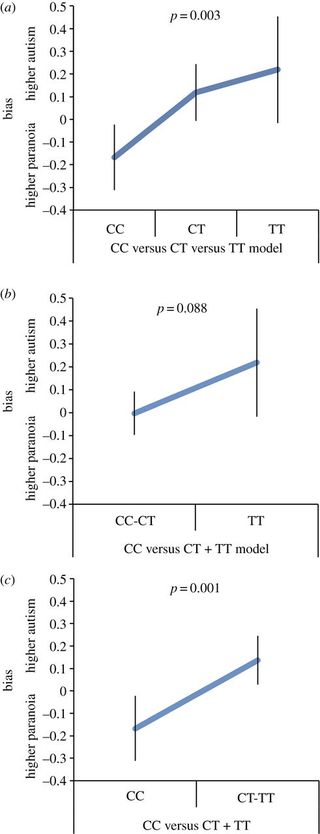Autism
Autism, Psychosis, and Sanity: Diametrics of Co-Morbidity
Normality could result from a balance between extremes of mentalism.
Posted August 18, 2018 Reviewed by Abigail Fagan
As I recounted in a previous post, the idea of what is now known as the diametric model of mental illness first occurred to me in 1997, originally purely in relation to paranoid schizophrenia being symptomatically opposite to autism. I realized from the beginning that a happy implication of this was that normality had to be a balanced position exactly halfway between the two, with enough mentalism to keep you from being autistic but not so much as to make you psychotic.
But as a debate which has now been published between the two other authors who originally developed this idea reveals, there is another way of describing normality, and that is as compensating co-occurrence of autistic and psychotic psychopathology in the same person. As I explained in my original post and as Ahmad Abu-Akel says here:
Crespi et al. report that genetic variation in the single-nucleotide polymorphism (SNP) rs850807 was strongly and exclusively associated with expression of paranoia symptoms in healthy carriers in whom autism and schizophrenia symptom expressions were assessed in tandem.
However, by not accounting for the putative trade-off/diametric relationship between autism and schizophrenia, their analytic approach may have obscured important insights about the association of rs850807 with both autism and schizophrenia, and the wider implication this genetic variation may have for Prader–Willi syndrome (PWS), in whom both autism and schizophrenia spectrum disorders co-occur at relatively high rates.

Here Abu-Akel puts his finger on the crucial issue: co-occurrence/co-morbidity. Abu-Akel and his associates have already found evidence for this as I noted in several previous posts. But now he has re-analyzed Crespi et al.’s data (see Figure 1) and as Crespi says in his invited reply:
Abu-Akel (…) presents clearly the benefits of analysing such data using as a key variable the psychosis–autism traits bias, with both combined on a single scale. This metric can quantify trait variation across the full, postulated psychosis–normality–autism continuum, and thereby test the theory most directly, subject to its assumptions being met. We applaud this approach for its elegance, and are pleased that its results recapitulate our results in novel ways.
The Abu-Akel analytic method is predicated, by way of caveat, on the genetic variation in rs850807 mediating phenotypic variation across the great hill and plateau of the normal distribution from psychosis to normality to autism; as such, the SNP and haplotype should affect autism as well as paranoia. It may well do so, but below our single-trait p-value radar; more data are needed to see if autism traits really exist to any notable degree in Prader–Willi syndrome; we say that they apparently do not and Abu-Akel presumes that they do.
An alternative possibility should also be considered: that any autism spectrum traits found in Prader–Willi syndrome might represent false-positives, motivated by high rates of obsessions and compulsions, and a predilection for jigsaw puzzles, in this syndrome.
False-positives, notably in diagnosing autistic versus psychotic symptoms, have been the bane of the diametric model from the beginning, for obvious reasons. But one consideration for which there is much evidence is that mentalism is modular and based on discreet brain systems performing different tasks, such as face and expression recognition and interpretation, voice perception and monitoring, imagination, empathy etc. If mentalism truly is modular, there is a possibility that different modules might be mentalistic to different extents in some cases. So, for example, a person might be somewhat autistic where facial recognition and interpretation was concerned, but hyper-mentalistic when it came to empathizing. Indeed, in a previous post I reported a case where brain surgery produced real hyper-empathy while leaving other mental modules untouched.
This suggests that co-occurrence of autistic and psychotic traits which cancel out to give a normal result could on occasion fail to do so and reveal co-morbid symptoms. Whether this is so in this particular case remains to be seen, but the possibility seems to me plausible. Indeed, I am already on record as believing that genius should be seen as the result of rare instances of creative co-occurrence of autistic and psychotic savantism in the same person, so why should pathological cases of co-morbid autism/psychosis not also exist?
Clearly, as Crespi himself says, more research is needed to discover which view is correct in this particular case. However, whatever the outcome, one thing is certain: Further investigations along these lines will go far towards resolving the fraught issue of co-morbidity on the mentalistic spectrum.
Both Abu Akel and Crespi and their colleagues are to be congratulated for taking an important step forward in this arduous but essential undertaking, one whose ultimate benefit will be to revolutionize diagnosis in psychiatry and reveal what passes for sanity to be a delicate balance between autism and psychosis, however achieved in any particular case.
Note: Thank you to Ahmad Abu-Akel for his help with this piece.




